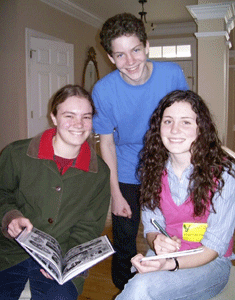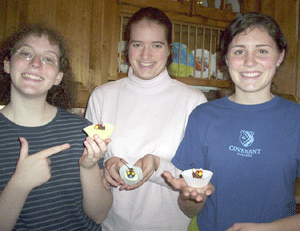
Homeschoolers have sports leagues, bands, and proms. So why not yearbooks?
Participating on the yearbook staff was a memorable activity during my school days. Our advisor helped us learn to do things that we had never imagined we could do. I thought this kind of experience would not be possible for my homeschooled children, but I soon discovered that it is!
Traditional yearbook publishers will now work with homeschool groups to create a quality yearbook that reflects the character and blessings of homeschooling families. Students have the opportunity to learn every aspect of yearbook staff, from selling ads to designing layout. They also have the rewarding experience of serving the homeschool community in a significant way by creating camaraderie and a sense of common purpose among families.

|
|
Planning is one of the most important tasks for the staff
|
How to Begin
The first step is to decide on a publisher and meet with a representative. They can explain all the options such as number of pages, types of cover, and even color choices. We learned that with the advent of new technology, color yearbooks are becoming as affordable as the traditional black-and-white yearbooks.
If you are comparing publishers, ask questions about how much support and training they provide. Some publishers provide only printing, while others have representatives that teach students how to use layout tools and other useful skills.
The key to signing a contract is making sure that there is enough support from the homeschool community. This is usually not too difficult, since a homeschool yearbook is marketed to students from pre-school through high school. However, for smaller groups or a new project, requiring families to pre-order before signing the contract is a good idea.

|
|
Our ad sales teams go out by twos and threes
|
Recruiting Students
Our primary goal is to give students the opportunity of working on a yearbook staff. We advertise widely in our area newsletter and also network with homeschoolers who are especially creative. For example, many of our recent members were recruited from participants in the local history fair. They had years of experience creating visual displays to communicate essential ideas.
We do not limit the size of our staff, because a large group benefits from a diversity of talents. We have students who take photographs, others who already understand Adobe Photoshop, and still others who have a gift for dreaming up designs.

|
|
Our staff benefits from a diversity of talents. Some are good at brainstorming and design.
|
Start Early
Starting early is one of the most important factors for creating a quality yearbook. From the moment we begin, we advertise the need for families to schedule portrait appointments and to send in candid pictures of student activities and academic pursuits. Since we use a professional photographer to take student portraits, we allow about two months for families to schedule appointments and return their proofs. It takes about five months to collect an adequate number of candid photos to begin the layout process. While we are waiting for the pictures to arrive, our staff meets to plan (and plan, and plan!).
Planning
A key role for the staff is planning the theme and how the pages will be used. It usually takes about three meetings to adequately brainstorm for our theme and how we will carry it throughout the yearbook. In addition, we decide on the content of each section of the yearbook.
Traditional yearbooks have sections for individual portraits by grade, academics by subject, and activities under categories such as sports, performing arts, clubs, etc.
Homeschool yearbooks, however, can have their own unique sections. For example, our yearbook has a section for family portraits. It is fun to see the families together, and it helps everyone get to know one another. We also have sections on "Service and Ministry," "Church activities," "Field Trips" (a rich and varied category for homeschoolers!), "Family Vacations," and "Pets and Critters." In addition we have a tradition of recognizing someone who has served the homeschool community on our "dedication page." Finally, we set aside about 15 percent of our pages for advertising.
After we determine how our pages will be used, the next step is to assign pages to staff members. For most pages we assign only one person, but certain projects benefit from having two staff members working together.
We also use our planning time to meet with our yearbook representative and learn how to use our design tools. We receive basic design tips and ideas on how to apply our chosen theme.

|
|
Homeschool yearbooks create a sense of comraderie among families
|
How to Meet Your Budget
What most people don't know about school yearbooks is that they are heavily supported by advertising. The average medium-sized, hard-cover, color yearbook costs about $45 and 30 percent of the cost is subsidized by businesses. This brings the price tag down to about $30 for each family. It also means that selling ads is crucial. For this reason, we recruit our staff with the understanding that everyone will sell ads. We gear up by offering monthly prizes (giant candy bars) for the most ad sales. We also award a quarter page ad to the top salesman at the end of the year. This is a popular prize for our students.
How to Sell Ads
We sell ads by sending letters to former sponsors, calling businesses, and visiting businessmen in person. By far the most successful method is the "personal visit." We find that it is less intimidating to send students by twos or threes. It also helps to have a cute, elementary-aged homeschooler in tow.
One business woman took the time to coach our staff on how to get the best results. Since we sell three sizes of ads, our business mentor advised the students to market the most expensive ads first and then offer the less expensive ads as an alternative. With this method, a higher percentage of sponsors bought the more expensive ads.
We also market ads to the parents of seniors to give them a chance to congratulate their students. For many families, the senior ad has become a traditional part of graduation.

|
|
With digital photography and computer design programs, students can create yearbooks from their home computers
|
Organization
Since yearbook publishers are making the process increasingly digital, it is critical to keep digital and hard copies of documents and photos. We use a notebook with tabbed dividers to keep track of ad forms, yearbook sales, senior information sheets, photos submitted, etc. We also regularly create back up disks to archive all photos submitted.
The Homeschool Way
A yearbook staff has great potential to harness the advantages of homeschooling: flexible schedules, the fostering of individual abilities, and the ingenuity of working on a large project from a home setting. With digital photography and computer design programs, students can create yearbooks from their home computers. We meet to learn how to use our program and to plan our theme, but much of the actual design work is accomplished in the home.
Our photographs are submitted digitally, both from the photography studio and from individual families who send them by email or digital upload. Our students log on to the publisher's site and have access to all our photos and design tools. They post their designs for the other students to see. In this way we share ideas on a day to day basis, but pare our meetings down to once a month.
The Learning Process
By working with a well-known yearbook company we also have access to a training seminar which teaches the students how to design layouts with unity in color, font type, and shape. They learn how to create a theme and carry it throughout the book. They are challenged to think about their audience and to create an appealing yearbook that includes as many families as possible. We even have a seminar on photography and Adobe Photoshop. Once you delve into this project, the possibilities for learning are endless.

|
|
Our yearbook booth at the Homeschool Fair
|
Nearing the Finish Line
The final step in yearbook production is proofing. It helps to involve as many people as possible in checking that names are spelled correctly and text is free from errors. We import text into a word-processing program to check for spelling errors. Since our publisher does not provide proofs, we print our own. We have learned that mistakes are easier to identify on a printed page.
Distribution
There are many ways to handle distribution: from yearbook-signing parties to support group meetings. In our case, we print and sell 150 yearbooks and feature over 500 students (partly because of large families, and partly because we cover large activities that include students who do not purchase the yearbook). In our homeschool community we distribute yearbooks at our annual homeschool fair in July. We staff a booth not only for distribution, but for recruiting new staff and selling yearbooks for the next school year.
Perhaps the most satisfying part of our project is sharing our creation with the homeschool families. For the staff who will be returning for another year, distribution furnishes a fresh stimulus to begin thinking about the next yearbook.
| Nuts and Bolts
Design Programs to Use
Popular design programs include Adobe Photoshop, Microsoft Publisher, Adobe InDesign, Pagemaker and Quark Xpress. Some companies provide their own programs.
How Many "dpi"
Dpi means "dots per inch." Since high resolution images are a requirement, the dpi should be at least 300. Cameras set to "high quality" and scanners working in "color photo" mode will provide the quality you need. Note that images from the internet are usually 72 dpi and will look grainy in print.
How to Work with a Professional Photographer
Many photography studios are willing to take portrait photos for a yearbook in their studio. In some cases they charge a small sitting fee. The studio markets photos to the families as a way to recoup their costs. Yearbook publishers provide instructions for how to submit the photos on a CD.
Setting Deadlines
It is important to establish deadlines for submission of all material that will be used in the yearbook. Working backwards from the date when the final draft must be submitted to the publisher, our rule of thumb is:
| Task |
Months prior to publisher's date |
| Candid photographs |
2 months |
| Senior information and senior ads |
4 months |
| Business ads |
5 months |
| Portraits made at the studio |
7 months |
Staff Size
Our homeschool organization has been making yearbooks for 10 years, but this is my first year as advisor. Over the years our staff has averaged six students and one adult, but homeschool parents often pitch in with extra help as needed. This year we have eight students and one adult. I would say a minimum number of students needed would be four students (however, our whole mindset is to get as many students involved as possible).
Pick a Publisher
We use Jostens, which is the Cadillac of yearbook publishers. Here is a short list of publishers for you:
|
 |
 |